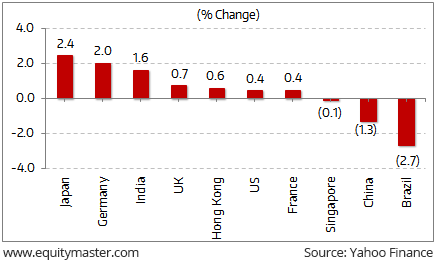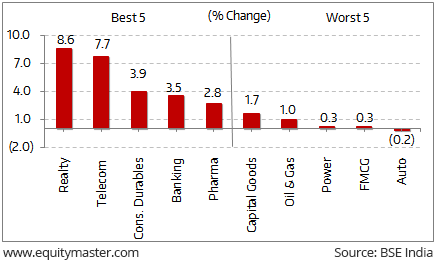Global market ended the week on a positive note. Japan’s index spiked above the 22,000 level for the first time since 1996. The benchmark index posted gains of 2.4% during the week. Robust corporate earnings coupled with broad economic improvements have led to the surge in the index.
Coming to the European markets, benchmark index in Germany and Britain too touched record highs during the week. Benchmark index in Germany posted gains of 2% during the week. Depreciation of Euro and Pound against the dollar have helped bolster shares of exporters in the European market.
Further, prices of crude oil surged to levels above 60 dollars during the week. From the lows of 30 dollars in 2016, the crude prices have now doubled. With, Organization of Petroleum Exporting Countries (OPEC) cutting production, global oil markets seem to be broadly balanced now after years of oversupply.
This sharp rise could be negative for corporates for whom crude and its derivatives is the main raw material. Paints, FMCG, aviation, oil and cosmetics industry are the industries which rely heavily on crude and its derivatives for its raw material requirement.
Key World Markets During the Week

Back home, benchmark indices in India too logged record highs as BSE Sensex closed at 33,686. Strong capital inflows and services PMI data coupled with decent corporate earnings led to the index surging by 1.6% during the week.
Majority of the sectoral indices ended the week on a positive note with stocks from realty and telecom sector gaining the most.
BSE Indices During the Week

Now let us discuss some key economic and industry developments during the week gone by
The Trend of Subdued Volume Growth Reversing for FMCG Companies
The volume growth as reported by top FMCG players in their second quarter results is nothing but encouraging. Heavyweights such as Hindustan Unilever India, Emami and Bajaj Corp reported decent volume growth of 4%, 10% and 5.1% respectively. The growth comes after back to back quarters of de-growth or sluggish growth.
A spurt in the volume growth essentially means that the FMCG players would now be in a better position to take price hikes. Henceforth, realizations could improve, leading to better margins.
However, it needs to be seen whether the spurt in the volumes is mainly on account of an increase in the demand from the end users. The reason why we say this, is because a lot of destocking had happened at the end of distributors in the first quarter. Restocking of goods in the second quarter may have contributed to the volume growth.
Provided, the volume growth has come in from the end user and that too from the rural territory, it would be good news for the FMCG companies.
India Broke into the Top 100 in the Ease of Doing Business Ranking
In the recent rankings as published by World Bank, India climbed almost 42 positions in the preceding two-three years, to make it to the 100th rank. From 142 in 2014, we are at 100 now.
The sharp jump was seen on the back of structural reforms like GST, RERA and the bankruptcy law.
However, the current ranking is still far off from the government’s desire to make it to the top 50. Amitabh Kant, CEO of Niti Aayog, states one way of getting close to the top 50 is to ease the granting of construction permits. He further goes on to state that permits should be available online, with no human intervention involved.
Further, he states that the judiciary process should be expedited by establishing commercial courts at district level. He also emphasizes to not give more than three adjournments which is what the civil procedure court entails. We give adjournments ad nauseam. So we need to bring it down to just three and you will see India making a big jump.













Leave A Comment